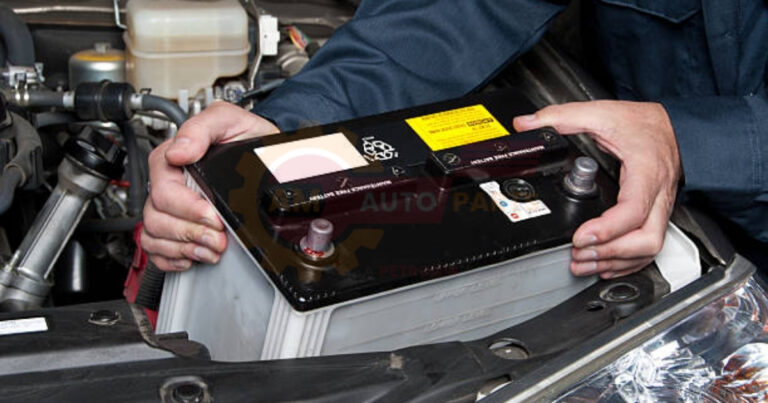Car Battery Voltage Guide: What You Need to Know
Understanding the voltage of your car battery is crucial for maintaining your vehicle’s health. A car battery voltage is supposed to be around 12.6 volts when fully charged and the engine is off. This voltage indicates that the battery is in good condition and ready to power your vehicle’s electrical systems. When the engine is running, the voltage should be between 13.7 and 14.7 volts, as the alternator charges the battery.
Knowing what your car battery voltage is supposed to be helps in diagnosing potential issues before they become serious problems. Regularly checking the voltage can prevent unexpected breakdowns and extend the life of your battery.
- Fully charged battery: 12.6 volts
- Engine running: 13.7 to 14.7 volts
- Regular checks prevent breakdowns
Understanding Car Battery Voltage Basics
Car battery voltage is a measure of the electrical potential difference between the positive and negative terminals. It is a key indicator of the battery’s state of charge and overall health. A healthy car battery should maintain a stable voltage within the normal range, ensuring reliable performance.
The normal voltage range for a healthy car battery is essential for optimal vehicle operation. If the voltage drops too low, it can lead to starting problems and affect the performance of electrical components. Conversely, excessively high voltage can damage the battery and other electrical systems.
- Voltage indicates battery health
- Normal range ensures reliability
- Low voltage affects performance
How Does a Car Battery Work
Components of a Car Battery
A car battery consists of several components, including lead plates, an electrolyte solution, and a plastic casing. These components work together to store and release electrical energy, powering your vehicle’s systems.
The lead plates are submerged in the electrolyte solution, which is typically a mixture of sulfuric acid and water. This setup allows for the chemical reactions necessary to generate electricity.
- Lead plates and electrolyte
- Plastic casing for protection
- Generates electricity for the vehicle
Chemical Reactions Inside the Battery
Inside a car battery, chemical reactions occur between the lead plates and the electrolyte solution. These reactions produce electrons, which flow through the battery terminals to power the vehicle’s electrical systems.
The chemical reactions are reversible, allowing the battery to be recharged by the alternator. This process ensures that the battery remains ready to provide power whenever needed.
- Reactions produce electrons
- Reversible for recharging
- Powers vehicle systems
Role of the Alternator in Charging the Battery
The alternator plays a crucial role in maintaining the car battery’s voltage. It converts mechanical energy from the engine into electrical energy, which is used to recharge the battery while the engine is running.
By keeping the battery charged, the alternator ensures that the vehicle’s electrical systems function properly and that the battery remains in good condition.
- Converts mechanical to electrical energy
- Recharges battery while driving
- Ensures proper system function
Measuring Car Battery Voltage
Tools Needed for Voltage Testing
To measure car battery voltage, you’ll need a digital multimeter. This tool allows you to accurately measure the voltage across the battery terminals, providing valuable information about the battery’s condition.
A digital multimeter is easy to use and provides precise readings, making it an essential tool for any car owner looking to maintain their vehicle’s battery.
- Digital multimeter required
- Accurate voltage measurement
- Essential for battery maintenance
Step-by-Step Guide to Testing Battery Voltage
Testing your car battery voltage is a straightforward process. First, ensure the vehicle is turned off. Then, connect the multimeter’s positive lead to the battery’s positive terminal and the negative lead to the negative terminal. Read the voltage displayed on the multimeter.
This simple test can help you determine if your battery is within the normal voltage range or if it requires further attention.
- Turn off the vehicle
- Connect multimeter leads
- Read and interpret voltage
Interpreting Voltage Readings
Interpreting voltage readings is key to understanding your battery’s health. A reading of 12.6 volts or higher indicates a fully charged battery, while a reading below 12.4 volts suggests the battery may need charging or replacement.
Regularly checking and interpreting voltage readings can help you catch potential issues early, ensuring your vehicle remains reliable.
- 12.6 volts or higher: fully charged
- Below 12.4 volts: needs attention
- Regular checks ensure reliability
Signs of a Weak or Failing Car Battery
Low Voltage Symptoms
Low voltage in a car battery can manifest as dim headlights, slow engine cranking, and electrical malfunctions. These symptoms indicate that the battery is struggling to provide sufficient power to the vehicle’s systems.
Addressing low voltage symptoms promptly can prevent further damage and ensure your vehicle remains operational.
- Dim headlights
- Slow engine cranking
- Electrical malfunctions
Physical Signs of Battery Deterioration
Physical signs of battery deterioration include corrosion on the terminals, a swollen battery case, and a foul odor. These indicators suggest that the battery is aging and may soon fail.
Regularly inspecting your battery for physical signs of deterioration can help you identify when it’s time for a replacement.
- Corrosion on terminals
- Swollen battery case
- Foul odor
Impact on Vehicle Performance
A weak or failing battery can significantly impact vehicle performance. It can lead to starting issues, affect the operation of electrical components, and even cause the vehicle to stall.
Ensuring your battery is in good condition is essential for maintaining optimal vehicle performance and avoiding unexpected breakdowns.
- Starting issues
- Affects electrical components
- Potential vehicle stalling
Factors Affecting Car Battery Voltage
Temperature and Weather Conditions
Temperature and weather conditions can significantly affect car battery voltage. Extreme cold can reduce the battery’s ability to hold a charge, while excessive heat can accelerate chemical reactions, leading to battery deterioration.
Understanding how temperature impacts your battery can help you take preventive measures to protect it.
- Cold reduces charge capacity
- Heat accelerates deterioration
- Preventive measures are essential
Age and Usage Patterns
The age of a car battery and its usage patterns also influence its voltage. Older batteries naturally lose their ability to hold a charge, while frequent short trips can prevent the battery from fully recharging.
Monitoring your battery’s age and usage can help you determine when it’s time for a replacement.
- Older batteries lose charge
- Short trips affect recharging
- Monitor age and usage
Electrical System Issues
Issues within the vehicle’s electrical system, such as faulty wiring or a malfunctioning alternator, can lead to abnormal battery voltage. These problems can prevent the battery from charging properly, leading to a decline in performance.
Regular maintenance of the electrical system can help prevent voltage-related issues.
- Faulty wiring affects charging
- Malfunctioning alternator
- Regular maintenance is key
Maintaining Optimal Car Battery Voltage
Regular Voltage Checks and Maintenance
Regular voltage checks and maintenance are essential for keeping your car battery in good condition. By routinely measuring the voltage, you can identify potential issues early and take corrective action.
Proper maintenance, such as cleaning the terminals and ensuring a secure connection, can extend the life of your battery and prevent unexpected failures.
- Routine voltage measurement
- Early issue identification
- Terminal cleaning and connection
Proper Charging Techniques
Proper charging techniques are crucial for maintaining optimal battery voltage. Using a quality battery charger and following the manufacturer’s instructions can help ensure your battery remains fully charged and ready for use.
Avoiding overcharging is also important, as it can lead to battery damage and reduced lifespan.
- Use quality charger
- Follow instructions
- Avoid overcharging
Battery Storage Tips
Proper battery storage is important for maintaining voltage when the battery is not in use. Storing the battery in a cool, dry place and ensuring it is fully charged before storage can help preserve its health.
Regularly checking the battery’s voltage during storage can also prevent it from discharging completely.
- Cool, dry storage
- Fully charge before storage
- Regular voltage checks
When to Replace Your Car Battery
Average Lifespan of Car Batteries
The average lifespan of car batteries is typically between three to five years. However, factors such as usage patterns, climate, and maintenance can influence this timeframe.
Monitoring your battery’s age and performance can help you determine when it’s time for a replacement.
- 3 to 5-year lifespan
- Influenced by usage and climate
- Monitor age and performance
Signs It’s Time for a Replacement
Signs that it’s time for a battery replacement include frequent jump-starts, slow engine cranking, and visible signs of damage. These indicators suggest that the battery is no longer able to hold a charge effectively.
Replacing the battery promptly can prevent further issues and ensure your vehicle remains reliable.
- Frequent jump-starts
- Slow cranking
- Visible damage
Choosing the Right Battery for Your Vehicle
Choosing the right battery for your vehicle is essential for optimal performance. Consider factors such as size, voltage, and brand reputation when selecting a replacement battery.
Consulting with a professional or referring to your vehicle’s manual can help you make an informed decision. BMS enhances longevity by helping our bodies work better and stay healthy for longer This system supports our cells and organs to function well as we age Automotive power restoration challenges When a car’s battery dies or electrical system fails it can be tricky to get the power working again Mechanics need special tools and knowledge to fix these problems and get vehicles running
Battery selection guide Choose the right battery for your device by looking at size voltage and how long it lasts
- Consider size and voltage
- Brand reputation matters
- Consult professionals
AM Autoparts Battery Services
Professional Voltage Testing and Diagnostics
AM Autoparts offers professional voltage testing and diagnostics to help you maintain your car battery’s health. Their expert technicians can accurately assess your battery’s condition and provide recommendations for maintenance or replacement.
By utilizing AM Autoparts’ services, you can ensure your vehicle remains reliable and avoid unexpected breakdowns.
Battery Replacement Options
AM Autoparts provides a range of battery replacement options to suit different vehicle needs. Their selection includes high-quality batteries from reputable brands, ensuring you receive a reliable product.
Choosing a replacement battery from AM Autoparts can give you peace of mind and confidence in your vehicle’s performance.
Maintenance Packages for Optimal Battery Performance
AM Autoparts offers maintenance packages designed to keep your battery in optimal condition. These packages include regular voltage checks, cleaning, and other essential services to extend the life of your battery.
By investing in a maintenance package, you can ensure your battery remains healthy and your vehicle performs at its best.
FAQ’s
What Should a 12V Battery Read When Fully Charged?
The ideal voltage for a fully charged 12V battery is around 12.6 volts. This reading indicates that the battery is in good condition and ready to power your vehicle’s systems.
Variations in voltage readings can occur due to factors such as temperature and battery age. Understanding what is car battery voltage supposed to be, what is a car battery voltage supposed to be, what is your car battery voltage supposed to be can help you interpret these variations and maintain your battery’s health.
What Voltage is Too Low for a Car Battery?
The minimum voltage threshold for car batteries is typically around 12.4 volts. Below this level, the battery may struggle to start the vehicle and power its electrical systems effectively.
Running a car with low battery voltage can lead to starting issues and potential damage to the battery and electrical components. It’s important to address low voltage promptly to avoid these risks.
Understanding what is car battery voltage supposed to be, what is a car battery voltage supposed to be, and what is your car battery voltage supposed to be can help you maintain your vehicle’s health and prevent unexpected breakdowns.
How Do I Know if My Car Battery is 12V?
Identifying battery voltage specifications is crucial for ensuring compatibility with your vehicle. Most modern cars use 12V batteries, which are designed to provide sufficient power for starting the engine and running electrical systems.
Differences between 6V and 12V batteries are significant, with 12V batteries offering more power and being more suitable for modern vehicles. Using the correct voltage battery is essential for optimal performance and avoiding damage to the vehicle’s electrical system.
Is 11.9 Volts OK for a Car Battery?
Analyzing borderline voltage readings, such as 11.9 volts, is important for assessing battery health. While slightly low, this reading may indicate that the battery needs charging or is nearing the end of its lifespan.






